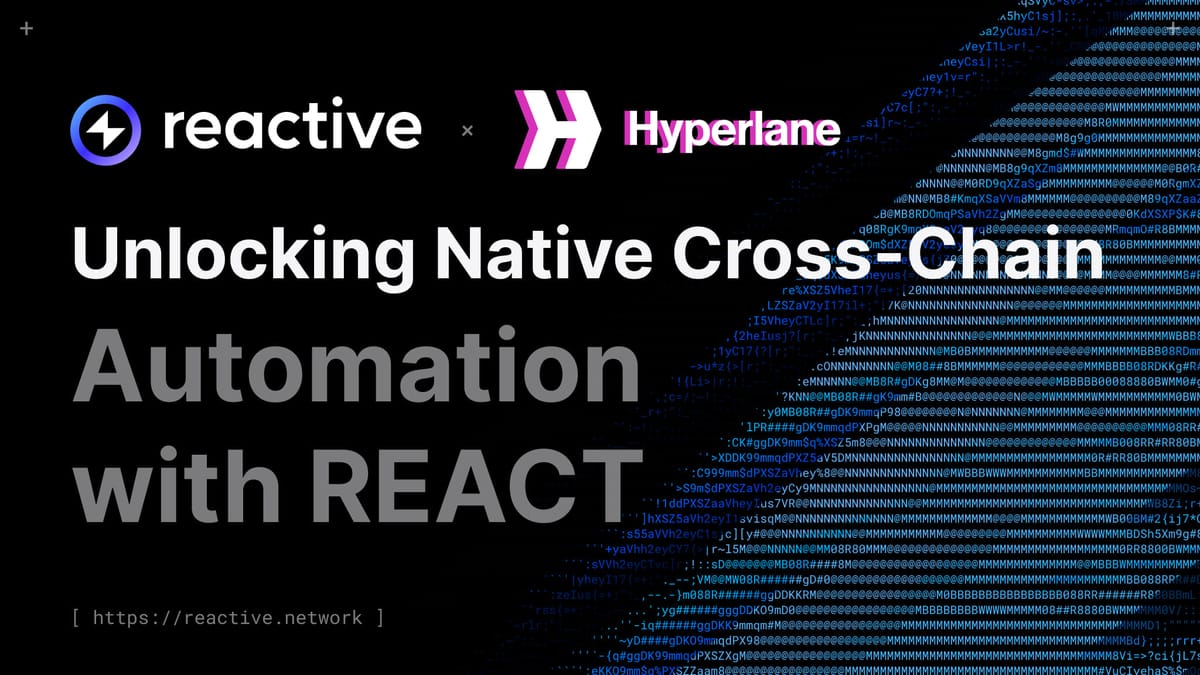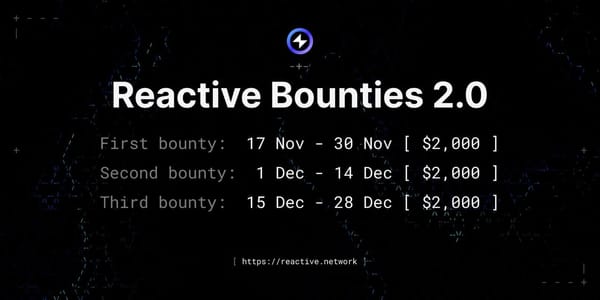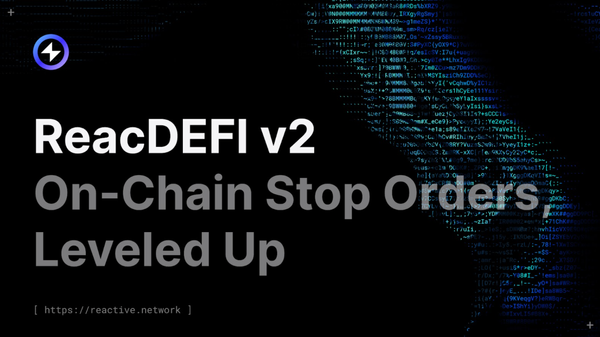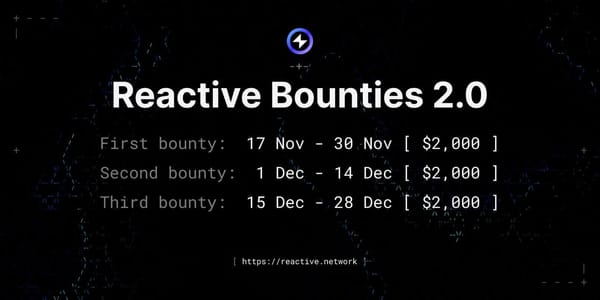Reactive Network x Hyperlane: Unlocking Native Cross-Chain Automation with REACT
Reactive Network is now integrated with Hyperlane, enabling fully decentralized cross-chain automation across 50+ blockchains—all powered by REACT as a universal gas token.

One of the most exciting milestones since mainnet—Reactive Network has officially become part of the Hyperlane ecosystem, a permissionless interoperability protocol that brings seamless cross-chain messaging to over 50 blockchains. This update doesn’t just extend our reach—it enables a fully decentralized transport layer for cross-chain automation and transforms the REACT token into a universal gas asset across supported chains.
While Reactive Smart Contracts (RSCs) have long been capable of monitoring and reacting to events across chains, the integration with Hyperlane unlocks something far more powerful: a scalable, permissionless, and decentralized message-passing layer that supports execution across 50+ destinations—without requiring off-chain infrastructure or relying on centralized relayers. Every step of the lifecycle, including gas fees, is now fully powered by REACT.
What Is Hyperlane?
Hyperlane is a general message passing (GMP) protocol designed for developers who need modular, secure, and decentralized cross-chain communication. Unlike traditional bridges that often introduce trust assumptions or centralized control, Hyperlane empowers anyone to deploy messaging across supported chains—permissionlessly.
Its architecture is built around "mailboxes" (smart contracts on each chain), Interchain Security Modules (ISMs) that allow for customizable message verification, and decentralized relayers that carry verified messages across chains. This approach gives builders flexibility, scalability, and resilience—without compromise.
How Reactive Network Integrates Hyperlane
This integration doesn’t introduce reactive automation itself—that’s been the core of Reactive from day one. What it brings is a major leap in infrastructure: developers can now build cross-chain applications that rely on fully decentralized message transport to 50+ chains, with execution powered entirely by REACT. Here’s how that works:
- Event Monitoring (Origin Chain): RSCs monitor defined on-chain events such as token transfers, oracle updates, or protocol state changes.
- Trigger & Message Creation: Once an event meets predefined conditions, the contract creates a message specifying the destination chain, target contract, payload, and necessary metadata.
- Message Relay (Hyperlane): This message is passed to Hyperlane’s mailbox, validated by Hyperlane’s decentralized network, and securely delivered to the destination chain.
- Execution (Destination Chain): Upon arrival, the message is received and the associated smart contract is triggered—executing the intended logic.
- All Paid in REACT: Every step of this process—message creation, relay, and execution—is settled using REACT. This removes the need to manage native gas tokens of other chains, simplifying both the user and developer experience.
Why This Integration Matters
REACT becomes a cross-chain gas token:No more juggling ETH, AVAX, or MATIC just to make things work. REACT now handles full cross-chain messaging, including transaction fees on the destination chain.
A Notable Milestone in Ecosystem Collaboration:While many projects aim for this level of integration, it often takes months or even years. With strong cooperation from the Hyperlane team, we were able to make it happen in just over a month.
True decentralized interoperability:This integration with Hyperlane marks the beginning of Reactive’s broader strategy to support multiple GMP solutions, reinforcing our commitment to avoid single points of failure and provide builders with a resilient, decentralized infrastructure.
Plug-and-play access to 50+ chains:Out of the box, developers can now build apps that interact with Ethereum, Arbitrum, Avalanche, Base, BNB Chain, Optimism, and dozens more.
Developer simplicity:No manual callbacks, no backend gas management, no hidden complexity. Reactive Smart Contracts handle everything—event → message → execution—automatically and transparently on-chain.
Strategic Significance
This is more than a technical improvement—it’s a strategic evolution. With Hyperlane integration, Reactive Network becomes a fully autonomous player in cross-chain automation. It now offers trustless, real-time messaging across chains without relying on centralized bridges or rigid tooling.
Just as importantly, this unlocks new utility for the REACT token. It is now the lifeblood for not just activity on Reactive Network, but also for executing smart contract logic across other ecosystems. From dApp creators to infrastructure projects, anyone building in Web3 can tap into Reactive's automation layer—and fuel it entirely with REACT.
This move sets a new bar for what’s possible in decentralized infrastructure. It shows that scalable, cross-chain apps don’t need to compromise on security or decentralization to be efficient.
What Developers Can Build Now
The integration is live. The REACT token is ready. And the tooling is available.
Start building dApps that are natively interoperable—across Ethereum and dozens of other EVM-compatible chains. Apps that can:
- Detect contract events on one chain and trigger responses on another.
- Run decentralized governance that spans multiple chains.
- Deploy AI agents that monitor price feeds on one chain and execute trades on another.
- Power reward systems, swaps, and user actions across chains—without ever leaving the Reactive ecosystem.
And here’s the kicker: you don’t need any gas token other than REACT.
The Future Is Automated—And REACT Is Fueling It
The full lifecycle of cross-chain execution is now permissionless, decentralized, and entirely paid in REACT. Hyperlane unlocks massive potential for Reactive Smart Contracts, turning the Reactive Network into a universal layer for automation across the blockchain world.
So go ahead. Monitor. Trigger. Execute. React.
With REACT, it’s all possible.
About Reactive Network
The Reactive Network, pioneered by PARSIQ, ushers in a new wave of blockchain innovation through its Reactive Smart Contracts (RSCs). These advanced contracts can autonomously execute based on specific on-chain events, eliminating the need for off-chain computation and heralding a seamless cross-chain ecosystem vital for Web3’s growth.
Central to this breakthrough is the Inversion of Control (IoC) framework, which redefines smart contracts and decentralized applications (DApps) by imbuing them with unparalleled autonomy, efficiency, and interactivity. By marrying RSCs with IoC, Reactive Network is setting the stage for a transformative blockchain era, characterized by enhanced interoperability and the robust, user-friendly foundation Web3 demands.
Website | Blog | Twitter | Telegram | Discord | Docs





